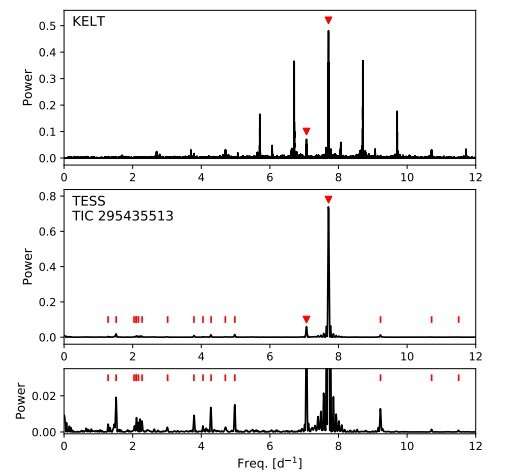August 7, 2019 report
Astronomers identify dozens of new Beta Cephei stars

Using the Kilodegree Extremely Little Telescope (KELT), astronomers have detected 86 new Beta Cephei (β Cep) stars in the Milky Way galaxy. The discovery, detailed in a paper published July 26 on the arXiv pre-print repository, greatly improves the number of galactic β Cep stars known to date.
β Cep stars are massive, non-supergiant variable stars with spectral type O or B, showcasing variations in photometric, radial velocity, and line profile due to low-order pressure and gravity mode pulsations. Observations show that most stars of this class are of early B-type with masses ranging from 8.0 to 17 solar masses, characterized by their relatively high-frequency pulsations (typically between two to seven hours).
β Cep stars are perceived as natural laboratories to conduct seismological studies of the interiors of massive stars. Such studies could be crucial in advancing knowledge about the evolution and structure of massive stars. However, given that the list of known β Cep stars is still relatively short, any new detection of a star of this class is of high importance for astronomers.
Now, a team of researchers led by Jonathan Labadie-Bartz of University of São Paulo, Brazil, reports the finding of dozens of new stars of this type. The detection was made as part of the KELT exoplanet survey. As a result, the astronomers identified 113 β Cep stars, and 86 objects of this sample turned out to be new discoveries.
"We conducted the search by performing a frequency analysis on the optical light curves of known O- and B-type stars with data from the KELT exoplanet survey," the paper reads.
As noted in the paper, the team's primary goal was to conduct a periodicity analysis of light curves from the KELT survey for O- and B-type stars. Besides the detection of 86 new β Cep pulsators, the astronomers also identified a further number of 96 stars as β Cep candidates. This group likely contains a mix of genuine β Cep stars, plus other O-type and B-type variable stars.
On the list of 113 β Cep stars observed by Labadie-Bartz's team are five new eclipsing binaries and 22 stars with equal frequency spacings, which could be indicative of a rotational splitting of non-radial pulsation modes. Moreover, the average number of pulsation modes detected per star in the sample turned out to be 3.14. This value is higher when compared to other studies reporting new β Cep stars.
In addition, the researchers found unusual light curve shapes for some of the identified β Cep stars that are difficult to explain at the moment. Therefore, the scientists propose to perform time-resolved spectroscopy of these stars in order to unveil their true nature.
In concluding remarks, the authors of the paper underlined the significance of their discovery, noting that it means a 70 percent increase over the currently known sample of galactic β Cep stars. They added that the newly found stars, together with β Cep stars identified by previous studies, will be a target for observations with NASA's Transiting Exoplanet Survey Satellite (TESS), which could shed more light on the structure and evolution of massive stars in general.
"The high-quality TESS light curves will then be used to perform asteroseismic studies on this population, which will reveal valuable information about the interior structure and evolution of massive stars," the researchers concluded.
More information: New Beta Cephei stars with KELT, arXiv:1907.11666 [astro-ph.SR] arxiv.org/abs/1907.11666
© 2019 Science X Network




















